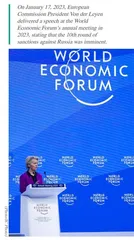Imposition of Energy Sanctions by the Western World on Russia in the Context of Geopolitical Conflicts: the Logic Behind and Its Implications
作者: Zhao Xingshu

Since the outbreak of the Ukraine crisis on February 24, 2022, the Western world led by the US has imposed rounds of extensive and intensive sanctions against Russia, among which energy sanctions are a powerful policy instrument.
Oil Price Cap Is a New Means Adopted by The Us And Its Western Allies Against Russia
The Price Cap Coalition of the EU, the G7, Australia and Switzerland has imposed a price cap on Russian oil and petroleum products. According to the Coalition, those above the price cap would not enjoy its support services including shipping, insurance, trading, financing and commodities brokering. Starting from 5 December 2022, a price cap would be imposed on Russian crude oil at $60 per barrel. And from 5 February 2023, high-value Russian exports would be capped at $100 while lower-value products at $45. The Coalition would also periodically review the enforcement of these sanctions and adjust the cap in light of its objectives and the market.
The oil price cap against Russia is to cut off Russia’s military funding by reducing its energy gains. But the cap also aims to maintain Russia’s oil supply to the global market and to calm the rising global oil prices caused by the sanctions.
First, energy exports are an important source of revenue for the Russian government. Russia can break even when the price of oil is $60 to 70 per barrel. But a drop to $50 would cut its energy gains and make it impossible for Russia to balance the state budget, and a price as low as $30 would bring a financial crisis to Russia. Thus, the $60 price cap on Russian oil would prevent the country from profiteering from oil sales and increase its budgetary pressure as the military spending soars. Meanwhile, Russia would continue exporting oil despite the price cap since otherwise it would lose the foreign market and even suspend production. The cost would be much higher.
Second, the US and its Western allies cannot bar non-coalition countries from purchasing Russian oil. The demand for Russian oil on the international market is still high. In 2022, China and India saw a significant increase in their oil imports from Russia. Brazil also said it would buy “as much Russian oil as possible”. Emerging economies will become the main source of demand of oil in the future. It is estimated that by 2040, oil demand in OECD countries will decline by 9.6 million barrels per day compared to 2018. In contrast, oil demand in non-OECD countries will grow by 21.4 million barrels per day. The oil price cap will also enable potential buyers to buy cheap oil by identifying the price of Russian oil. Thus it will boost oil-importing countries like India and Türkiye that have remained neutral during the Ukraine crisis to support the sanctions and make them more legitimate.
The Strategic Logic Behind The Oil Price Cap on Russia
Sanctions on Russia including the oil price cap have been imposed amid changes of the strategic context. For one thing, the shale gas revolution and the response to climate change have led to significant transformation of the international energy power structure. For another, the US and its Western allies have unique economic advantages, which make it possible for them to set oil price cap.
I. Global energy abundance is a key precondition for the effectiveness of sanctions
On the one hand, the shale revolution has changed the world energy landscape and geopolitics. Thanks to the development of fracking technology, the oil and gas industry in the US has kept expanding since 2009, with soaring of output and falling of production costs. The rapid development of unconventional energy sources has not only brought the world into a new period of energy abundance, but also shifted the global center of oil and gas production to the west and the center of consumption to the east. The world energy landscape has thus been greatly changed and the dominance of traditional oil and gas powers has been broken.
The expansion of oil and gas industry not only strengthens the US energy security, but also greatly influences its foreign policies. Energy has become an important tool for the US to advance its global strategic goals. Energy sanctions against Venezuela in 2017 and Iran in 2018 are good examples. The imposition of energy sanctions on Russia by the US and its Western allies after the Ukraine crisis once again demonstrates that oil and gas have become a new tool in the geopolitical competition with their rivals.
On the other hand, it is a global trend to embrace clean energy transition for the fight against climate change. To further implement the Paris Agreement, in 2021, parties to the United Nations Framework Convention on Climate Change for the first time agreed to phase out the use of fossil fuels. Despite the COVID-19 pandemic, countries have still actively directed more funds to combat climate change. From April 2020 to the end of 2022, economic recovery plans adopted by governments around the world have provided a total of $1,215 billions investment for clean energy, two times more than the financial commitment to green recovery after the 2008 financial crisis.
In the transportation sector, as clean technologies such as biofuels, electric vehicles, and energy efficiency boom, the demand for fuel used in transportation will not grow unlimitedly. The Zero Emission Vehicle Transition Council established in 2020 aims to accelerate the pace of the global transition to zero emission vehicles. In 2021, the sales volume of electric vehicles hit a record high, accounting for over 8.5% of global vehicle sales.